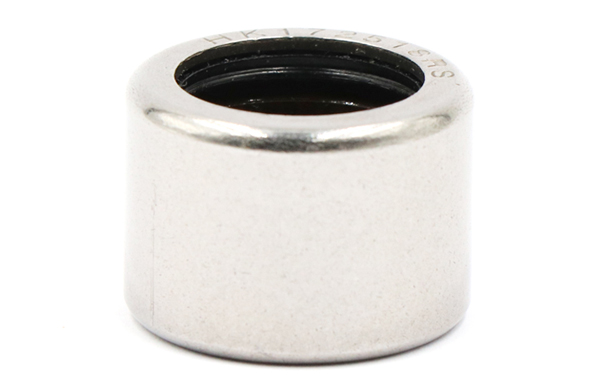The rolling bearing is a precise mechanical element that changes the sliding friction between the running shaft and the shaft seat into rolling resistance, thereby reducing friction losses. Rolling bearings are generally composed of four parts: an inner ring, an outer ring, a rolling body, and a cage. The role of the inner circle is to cooperate with the shaft and rotate with the shaft. The purpose of the outer ring is to work with the bearing seat to support the role. The rolling body is assisted by Because the cage evenly distributes the rolling elements between the inner and outer rings, its shape and quantity directly affect the service performance and life of the rolling bearing. The cage can evenly distribute the rolling elements and guide the rolling elements to rotate for lubrication.
Classification of rolling bearings
1.Deep groove ball bearing
Deep groove ball bearings have a simple structure and are easy to use. They are the type of bearings with the most significant production volume and the most extensive application range. It is mainly used to withstand radial loads and can also withstand sure axial loads. When the radial clearance of the bearing is increased, it has the function of an angular contact bearing and can bear a large axial load. Used in automobiles, tractors, machine tools, motors, pumps, agricultural machinery, textile machinery, etc.
2. Needle bearing
Needle roller bearings are equipped with thin and long rollers, so the radial structure is compact. When the inner diameter size and load capacity are the same as other types of bearings, the outer diameter is the smallest, which is especially suitable for support structures with limited radial installation dimensions. Depending on the application, a bearing or needle roller and cage assembly without an inner ring can be used. At this time, the journal surface and the housing hole surface that match the bearing are directly used as the inner and outer rolling surfaces of the bearing to maintain load capacity and running performance. As with the bearing with the ring, the hardness of the surface of the shaft or housing raceway. The machining accuracy and surface and surface quality should be similar to the raceway of the bearing ring. This type of bearing can only support radial loads. For example, a universal joint shaft, hydraulic pump, sheet rolling mill, rock drill, machine gearbox, automobile, and tractor gearbox.
3.Angular contact bearings
Angular contact ball bearings have a higher limit speed and can support both meridional and axial loads, as well as pure axial loads. The axial load capacity is determined by the contact angle and increases with the contact angle. Mostly used: oil pumps, air compressors, various transmissions, fuel injection pumps, printing machinery.
4. Self-aligning ball bearings
Self-aligning ball bearings have two rows of steel balls, and the inner ring has two raceways. The outer ring raceways have an internal spherical shape and have automatic self-aligning performance. It can automatically compensate for the coaxiality error caused by the bending of the shaft, and the deformation of the housing and is suitable for parts where the support seat hole cannot guarantee strict coaxiality. This bearing mainly bears the radial load. It can also take a small amount of axial load at the same time as the radial load. It is usually not used to take the pure axial load. For example, only a row of steel balls is subjected to absolute axial load. It is mainly used in agricultural machinery such as combine harvesters, blowers, paper machines, textile machinery, woodworking machinery, bridge crane wheels, and driveshafts.
5. Thrust ball bearings
The thrust ball bearing is a separate type bearing, and the "washer" of the shaft washer can be separated from the components of the cage steel ball. The shaft ring is a ferrule matching the shaft, and the seat ring is a ferrule matching the bearing seat hole, and there is a gap between the shaft and the shaft. Thrust ball bearings can only bear axial loads, one-way thrust ball bearings can alone carry axial loads in one direction, and two-way thrust ball bearings can carry axial loads in two courses. The thrust ball can not limit the radial displacement of the shaft, and the limiting speed is deficient. One-way thrust ball bearings can limit axial movement in one direction of the shaft and housing, and two-way bearings can limit axial movement in both directions. Mainly used in automobile steering mechanism and machine tool spindle.

Selection of rolling bearings
There are many types of rolling bearings, and the following factors can be taken into consideration when selecting them.
1. The size, direction, and nature of the load
Ball bearings are suitable for light loads, and roller bearings are suitable for heavy and shock loads. When rolling bearings are subjected to pure axial loads, thrust bearings are generally selected. When rolling bearings are subjected to pure radial loads, deep groove ball bearings or short cylindrical roller bearings are generally used. When rolling bearings are subjected to pure radial loads, there is not much When the axial load is broad, deep groove ball bearings, angular contact ball bearings, tapered roller bearings, and spherical or spherical roller bearings can be selected. When the axial load is significant, angular contact with a larger contact angle can be selected. Ball bearings and tapered roller bearings, or a combination of radial and thrust bearings, is particularly suitable when extremely high axial loads or particularly require greater axial rigidity.
2. Allowable speed
There are great differences depending on the type of bearing. Generally, bearings with low friction and low heat generation are suitable for high speed. The design should strive for the rolling bearing to work below its limit speed.
3.rigid
When the bearing is under load, elastic deformation occurs at the contact between the bearing ring and the rolling element. The amount of deformation is proportional to the load. The ratio determines the rigidity of the bearing. Generally, the rigidity of the bearing can be improved by the pre-tensioning of the bearing. In addition, in the bearing support design, considering the combination and arrangement of the bearings can also improve the bearing rigidity.
4. Self-aligning performance and installation error
After the bearing is installed in the working position, the installation and positioning are often poor due to manufacturing errors. At this time, the bearing often bears excessive loads due to the fishing and thermal expansion of the shaft, causing early damage. Self-aligning bearings can overcome the defects caused by installation errors by themselves, so they are suitable for this purpose.
5. Installation and removal
Tapered roller bearings, needle bearings, etc., are bearing types with separable inner and outer rings (so-called separate bearings), and are easy to install and remove.

Routine maintenance of rolling bearings
1. Is it required for the installation surface and installation site?
Yes. If foreign matter such as iron filings, burrs, dust, etc. enter the bearing, it will cause noise and vibration during the operation of the bearing, and may even damage the raceways and rolling elements. Therefore, before installing the bearings, the installation surface and the installation environment must be clean.
2. Must the bearings be cleaned before installation?
The surface of the bearing is coated with anti-rust oil. It must be carefully cleaned with clean gasoline or kerosene and then coated with clean, high-quality, or high-speed and high-temperature lubricants before installation. The effect of cleanliness on bearing life and vibration noise is very large.
3. How to choose grease?
Grease is made of base oil, thickener, and additives. The performance of different types and greases of the same type and brand is very different. The allowable rotation limit is different. Please pay attention when selecting. The performance of grease is mainly determined by the base oil. Generally, low viscosity base oil is suitable for low temperature and high speed, and high viscosity is suitable for high temperature and high load. The thickener is also related to lubricating performance. The water-resistance of the thickener determines the water-resistance of the grease. In principle, different brands of grease cannot be mixed, and even greases of the same type of thickener will have adverse effects on each other due to different additives. Fourth, when lubricating bearings, the more grease is better? When lubricating bearings, the more grease is better, this is a common misconception. Excessive grease in bearings and bearing chambers will cause excessive agitation of the grease, which will result in extremely high temperatures. The amount of lubricant filled in the bearing is preferably 1/2 to 1/3 of the inner space of the bearing.
Hot Tags: